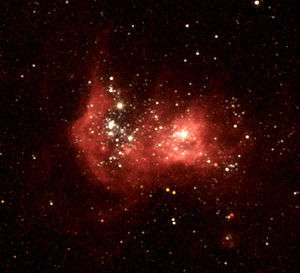NGC 2363-V1
NGC 2363-V1 is a luminous blue variable star in the star-forming region NGC 2363, at the far southwestern part of the irregular galaxy NGC 2366 in the constellation Camelopardalis, near the North Celestial Pole approaching 11 million light years away from our galaxy. It was discovered in 1996 by Laurent Drissen, Jean-René Roy, and Carmelle Robert while examining images taken by the Hubble Space Telescope Wide Field Planetary Camera 2.[1]
 The H II region NGC 2363 as seen by the Hubble Space Telescope. NGC 2363-V1 is the isolated bright star above and left of centre.[1] Credit: NASA/ESA | |
| Observation data Epoch J2000.0 Equinox J2000.0 | |
|---|---|
| Constellation | Camelopardalis |
| Right ascension | 07h 28m 43.37s[1] |
| Declination | +69° 11′ 23.9″[1] |
| Apparent magnitude (V) | 17.88[1] |
| Characteristics | |
| Evolutionary stage | LBV |
| Spectral type | LBV |
| Variable type | LBV |
| Astrometry | |
| Distance | 10,800,000 ly (3,300,000[2] pc) |
| Absolute magnitude (MV) | -10.25[1] |
| Details | |
| Mass | ~20[3] M☉ |
| Radius | ~200[4] R☉ |
| Luminosity (bolometric) | 6,300,000[4] L☉ |
| Temperature | 13,000 - 26,000[4] K |
| Metallicity [Fe/H] | -1 - -0.6[2] dex |
| Age | 4-5 million[5] years |
| Database references | |
| SIMBAD | data |
NGC 2363-V1 is one of the most luminous stars known. It has been undergoing an increase in temperature and luminosity for the last 20 years, after a dramatic increase in its rate of mass loss. Significant luminosity variation within a human lifetime is rare in LBVs, e.g. Eta Carinae during its Great Eruption (1837 to 1855). NGC 2363-V1 shows an extreme B hypergiant spectrum similar to P Cygni rather than the presently cool Eta Carinae outburst spectrum.[1][2]
References
- Drissen, Laurent; Roy, Jean-René; Robert, Carmelle (1997). "A New Luminous Blue Variable in the Giant Extragalactic H II Region NGC 2363". The Astrophysical Journal. 474: L35. Bibcode:1997ApJ...474L..35D. doi:10.1086/310417.
- Petit, Véronique; Drissen, Laurent; Crowther, Paul A. (2006). "Spectral Evolution of the Luminous Blue Variable NGC 2363-V1. I. Observations and Qualitative Analysis of the Ongoing Giant Eruption". The Astronomical Journal. 132 (5): 1756. Bibcode:2006AJ....132.1756P. doi:10.1086/506512.
- Habergham, S. M.; Anderson, J. P.; James, P. A.; Lyman, J. D. (2014). "Environments of interacting transients: Impostors and Type IIn supernovae". Monthly Notices of the Royal Astronomical Society. 441 (3): 2230. arXiv:1404.2282. Bibcode:2014MNRAS.441.2230H. doi:10.1093/mnras/stu684.
- Clark, J. S.; Crowther, P. A.; Larionov, V. M.; Steele, I. A.; Ritchie, B. W.; Arkharov, A. A. (2009). "Bolometric luminosity variations in the luminous blue variable AFGL2298". Astronomy and Astrophysics. 507 (3): 1555. arXiv:0909.4160. Bibcode:2009A&A...507.1555C. doi:10.1051/0004-6361/200912358.
- Drissen, Laurent; Crowther, Paul. A; Smith, Linda J.; Robert, Carmelle; Roy, Jean-René; Hillier, D. John (2000). "Physical Parameters of Erupting Luminous Blue Variables: NGC 2363-V1 Caught in the Act". The Astrophysical Journal. 546 (1): 484. arXiv:astro-ph/0008221. Bibcode:2001ApJ...546..484D. doi:10.1086/318264.